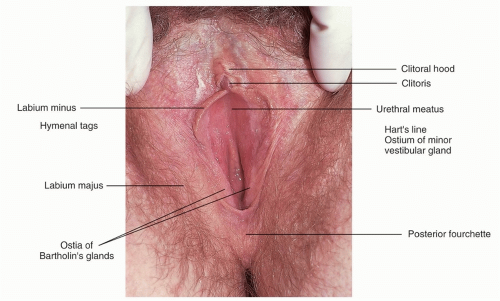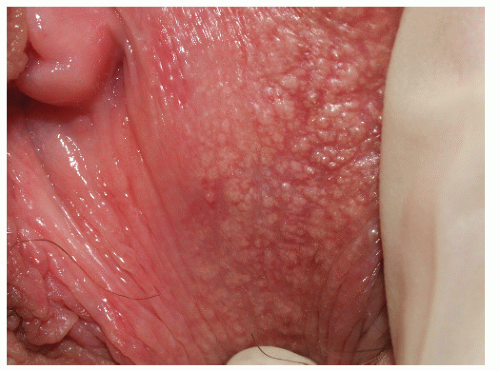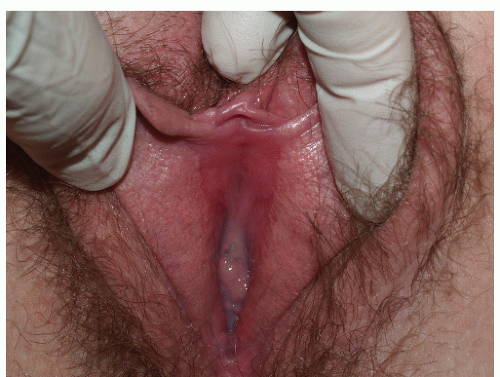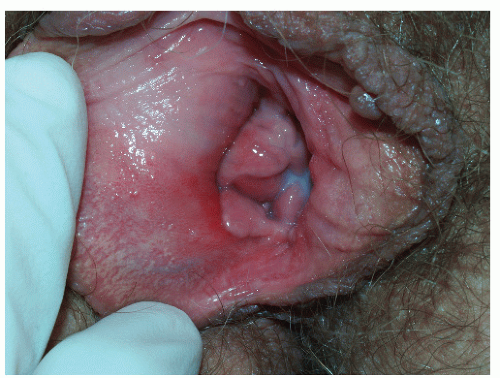Genital Anatomy
Libby Edwards
Dermatoses on genital skin often present differently than when occurring on extragenital dry, keratinized skin surfaces. Scaling is inapparent in damp skin folds, and some diseases, such as lichen sclerosus, preferentially affect modified mucous membrane skin rather than true mucous membrane. A knowledge of anatomy helps with the recognition of both normal structures and pathologic findings, as well as choices of therapy.
FEMALE GENITALIA
Vulva
The vulva consists of the mucocutaneous structures that compose the external female genitalia (Fig. 1-1 and Table 1-1). The vulva extends from the mons pubis anteriorly to the perineum posteriorly and from the crural folds laterally to the hymen and hymeneal ring medially.
The labia majora (singular = labium majus) are two fatty folds of skin that are derived from ectodermal tissues. The labia minora (singular = labium minus), medial to the labia majora, are much thinner folds of connective tissue and squamous epithelium. The vestibule, or introitus, is mucous membrane that extends from the medial origin of the labia minora to the hymeneal ring. The mons and labia majora cover and protect more delicate structures such as the clitoris, the clitoral hood, the labia minora, the vestibule, and the posterior fourchette, which is the posterior vestibule, extending to the perineal body.
The vulva exhibits several different types of epithelium. The lateral aspect of the labia majora is covered with dry, keratinized, conspicuously hair-bearing skin. Each hair follicle is part of a pilosebaceous unit comprising the follicle itself, its hair shaft, sebaceous gland, and the erector pili apparatus—a smooth muscle that contracts to form gooseflesh.
Although the medial aspect of the labia majora and the entire labia minora are generally considered to exhibit hairless mucous membrane epithelium, these areas actually are covered with partially keratinized skin that contains several structures, including subtle hair follicles. Numerous apocrine sweat glands lie on the modified mucous membranes of the labia minora, and ectopic sebaceous glands are often prominent, especially on the medial aspect of these skin folds. Sebaceous glands appear as small, yellow to white, lobular papules that occasionally enlarge to become nearly confluent (Figs. 1-2 and 1-3). A variably distinct line of demarcation (the Hart line) is evident at the base of the medial aspect of each labium minus, separating modified mucous membrane from the mucous membrane skin of the vestibule. The medial aspect of the labia majora and the entire labia minora display moist, partially keratinized modified mucous membrane. Mucosa, unkeratinized, non-hair-bearing epithelium with mucus-secreting glands, extends from the Hart line to and including the vagina and the external surface of the cervix. Mucosa is defined as ectodermal tissue that lines tubular structures and comprises the epithelium, basement membrane, lamina propria mucosa, and lamina muscularis mucosa. Mucous membrane skin also differs from keratinized squamous epithelium by the absence of a granular layer. In general, mucous membrane skin is non-hair-bearing epithelium that contains mucus-secreting glands. Both the vagina and the vestibule are mucosae, with surfaces that are variably wet (depending on estrogen status) as a result of mucous produced by associated glands and the cervix.
The vestibule, the innermost portion of the vulva, extends from the Hart line to the hymen. Variable numbers of mucus-secreting vestibular glands open onto the mucous membrane of this area. These glands are shallow pits lined with secretory cells; these primarily open circumferentially around the external aspect of the hymeneal ring and between the hymen and urethra (Fig. 1-4). They supplement lubrication in young, postpubertal women. Bartholin glands are paired glands that lie under the posterior portion of the vestibule, with duct openings just outside the hymen at the 5 and 7 o’clock positions. Skene glands exit into the distal urethra.
The vulva undergoes marked change from birth until puberty (see Chapter 14). The skin of the mons and the lateral labia majora is characterized by fine vellus hair at birth, but with puberty, coarse terminal hair appears. In addition, the labia minora are almost absent until puberty, and they enlarge at puberty. Apocrine glands become better developed with sexual maturity.
Normal Variants
Similar to the mucous membrane epithelia of the mouth and conjunctivae, mild erythema of the vulva and
vagina is normal and varies from patient to patient. In one reported series of premenopausal women, 43% showed erythema (Fig. 1-5) (1). This redness is more evident in patients of light complexion, especially those with a naturally ruddy complexion. This finding is often misinterpreted by patients and their physicians as indicative of inflammation because the asymptomatic vulva is rarely examined critically. In addition, more than half of the women with vestibular erythema report no dyspareunia, but experience pain when the area is touched with a cotton-tipped applicator (the Q-tip test). This indicates that redness and a positive Q-tip test are normal findings and do not, alone and in the absence of real-life symptoms, constitute vulvodynia/vestibulodynia/vulvar vestibulitis syndrome.
vagina is normal and varies from patient to patient. In one reported series of premenopausal women, 43% showed erythema (Fig. 1-5) (1). This redness is more evident in patients of light complexion, especially those with a naturally ruddy complexion. This finding is often misinterpreted by patients and their physicians as indicative of inflammation because the asymptomatic vulva is rarely examined critically. In addition, more than half of the women with vestibular erythema report no dyspareunia, but experience pain when the area is touched with a cotton-tipped applicator (the Q-tip test). This indicates that redness and a positive Q-tip test are normal findings and do not, alone and in the absence of real-life symptoms, constitute vulvodynia/vestibulodynia/vulvar vestibulitis syndrome.
TABLE 1.1 Genital comparative anatomy | ||||||||||||||||||
|---|---|---|---|---|---|---|---|---|---|---|---|---|---|---|---|---|---|---|
|
Vulvar papillae (see Chapter 12) are also common normal variants, occurring in about one third of premenopausal women (Figs. 1-6, 1-7, 1-8, 1-9 and 1-10). When these occur in the vestibule, they are called vestibular papillae. These variants are often mistaken for signs of disease, usually condylomata acuminata. Initial descriptions of vulvar papillomatosis reported biopsies consistent with human papillomavirus (HPV) infection as the cause. However, biopsies of even normal vulvar skin generally show large, clear keratinocytes that mimic koilocytes of HPV infection. More recent studies have evaluated for the
actual presence of the virus. The current consensus is that vestibular papillomatosis is a variant of normal, and this morphology is distinct from HPV infection (2,3). These small, filiform, soft, monomorphous, tubular projections are located symmetrically within the vestibule, whereas papillae of other areas of the vulva are more likely to be dome-shaped and less filiform. Vulvar papillae differ from condylomata acuminata by their rounded rather than acuminate tips, symmetric pattern, and discrete rather than fused base of adjacent lesions. Moreover, genital warts are often keratinized and appear white in this moist area. Occasionally, similar dome-shaped, smooth papules that coalesce into a cobblestone texture to the inner labia minora occur in some women. Sometimes, these lesions form papules on the edge of the labia minora. These changes are also often mistaken for warts. Although vulvar papillae were once believed to produce itching or pain, they are now known to be asymptomatic.
actual presence of the virus. The current consensus is that vestibular papillomatosis is a variant of normal, and this morphology is distinct from HPV infection (2,3). These small, filiform, soft, monomorphous, tubular projections are located symmetrically within the vestibule, whereas papillae of other areas of the vulva are more likely to be dome-shaped and less filiform. Vulvar papillae differ from condylomata acuminata by their rounded rather than acuminate tips, symmetric pattern, and discrete rather than fused base of adjacent lesions. Moreover, genital warts are often keratinized and appear white in this moist area. Occasionally, similar dome-shaped, smooth papules that coalesce into a cobblestone texture to the inner labia minora occur in some women. Sometimes, these lesions form papules on the edge of the labia minora. These changes are also often mistaken for warts. Although vulvar papillae were once believed to produce itching or pain, they are now known to be asymptomatic.
 FIG. 1-4. Just external to the hymeneal ring are several pits (arrows) that represent openings to the vestibular glands. Occasionally, these can be found in other areas of the vestibule. |
The whitening of vulvar skin following the application of 5% acetic acid has been believed to be pathognomonic of HPV infection. However, this is a nonspecific finding occurring with any condition that produces hyperkeratosis or thickening of the skin. Some investigators have
found that 5% acetic acid predictably produces acetowhitening of all vulvar skin (1).
found that 5% acetic acid predictably produces acetowhitening of all vulvar skin (1).
Stay updated, free articles. Join our Telegram channel

Full access? Get Clinical Tree












